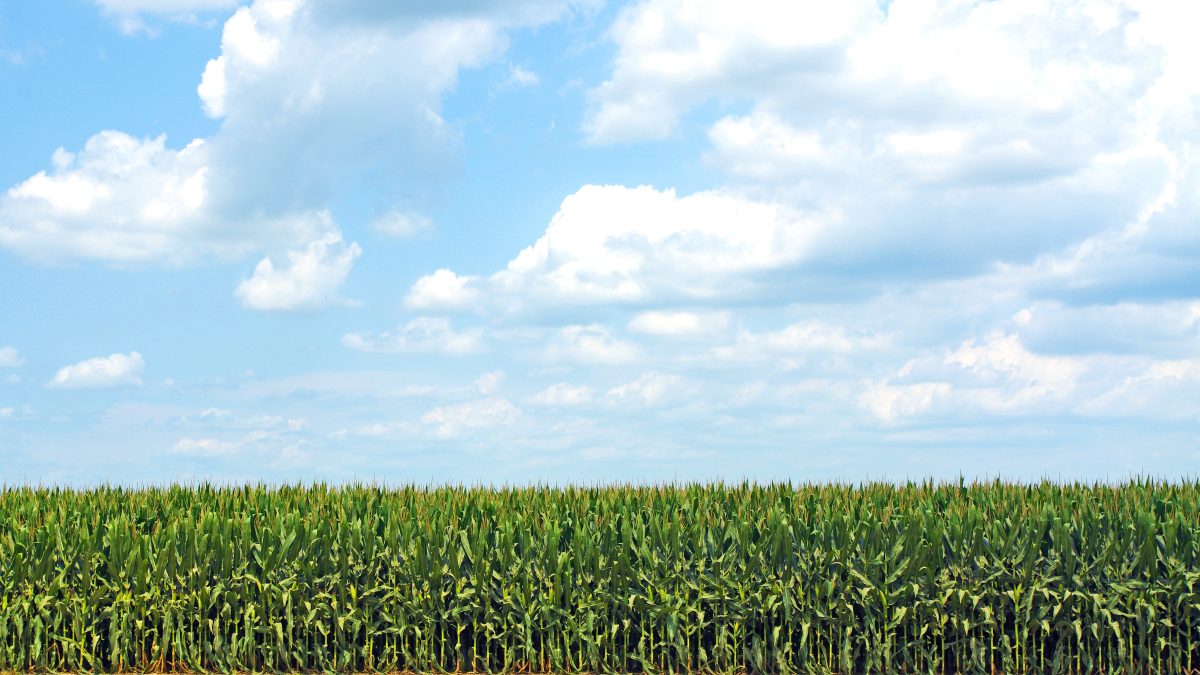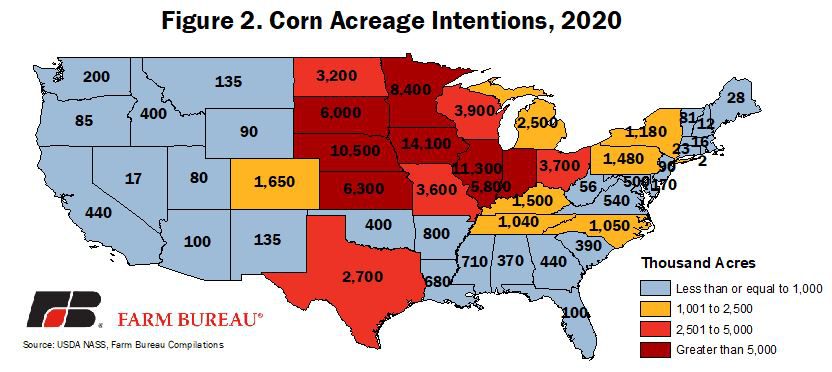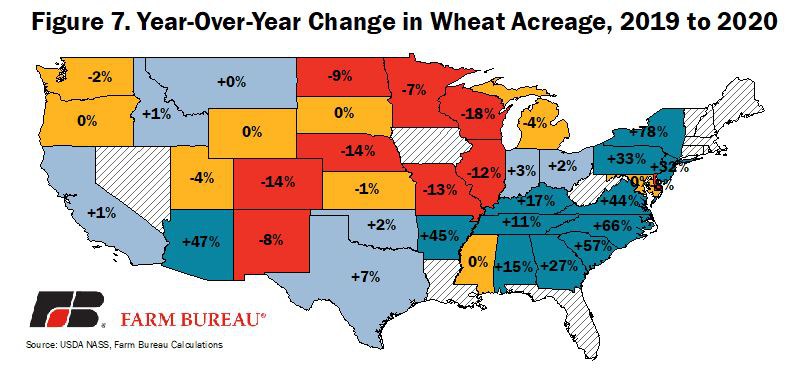2020 Prospective Plantings: Corn Soars, Soybeans Bounce, Wheat Falls
TOPICS
Wheat
photo credit: Arkansas Farm Bureau, used with permission.
Shelby Myers
Former AFBF Economist
USDA’s annual Prospective Plantings report, released on March 31, provides the first look at farmers’ planting intentions for corn, soybeans and wheat in 2020. Normal survey procedures were conducted during the first two weeks of March before USDA implemented COVID-19 precautions and switched all surveys to online-only.
During its 2020 Agricultural Outlook Forum in February, USDA estimated farmers would plant 94 million acres of corn, 85 million acres of soybeans and 45 million acres of wheat. The 2020 Outlook Market Intel dives into those projections. In anticipation of the prospective plantings release, market analysts’ estimates had corn between 92 million and 96.4 million acres. For soybeans, estimates were between 82.7 million and 87.5 million acres and all wheat estimates were between 44 million and 46 million acres. On average, analysts pegged corn acreage at 94.3 million, soybean acreage at 85 million and all wheat acreage at 45 million.
USDA’s prospective plantings survey results indicate farmers intend to plant 97 million acres of corn, 83.5 million acres of soybeans and 44.7 million acres of wheat. Compared to USDA’s February estimates, corn planted acres increased by 3 million. The prospective planting report also indicates farmers intend to plant 7.3 million more corn acres than in 2019, a projected 8% year-over-year increase. The prospective soybean acres to be planted in 2020 are 1.5 million acres fewer than USDA’s February estimates, but up 7.4 million acres, or 10%, compared to 2019’s significantly low soybean production year of 76.1 million planted acres. Wheat survey results are down 400,000 acres from the February estimates and 600,000 acres less than 2019, a year-over-year decrease of 1%. Figure 1 displays 2019 crop acres and the estimates for the February Outlook, pre-report estimates from traders and the 2020 prospective plantings.

USDA projects corn growers will plant 97 million acres of corn in the 2020/2021 marketing year, up 8%, or 7.3 million acres, from last year. If fulfilled, corn planted acres will be the highest since 2012. Corn acreage is expected to be the highest in Iowa with 14.1 million acres, up 4% from 2019, followed by Illinois with 11.3 million acres, up 8% from 2019, and Nebraska with 10.5 million acres, up 4% from 2019. Figure 2 displays each state’s intended corn acres for 2020.

Compared to 2019, during which a record amount of prevent planting claims were filed, corn planted acreage is expected to increase or have no change in 38 of the 48 corn-producing states. The largest change in planted acreage is estimated to be in South Dakota, where 6 million acres are to be planted, compared to 4.3 million in 2019. South Dakota farmers claimed 2.9 million corn acres as prevent plant in 2019. Farmers in Ohio have the second-largest increase in corn planted acres, intending to plant 3.7 million corn acres in 2020, compared to 2.8 million in 2019. Ohio farmers claimed 928,000 corn acres as prevent plant in 2019. Figure 3 shows each state’s year-over-year change in corn acres to be planted.

For soybeans in the 2020/2021 marketing year, USDA estimates planted area to be 83.5 million acres, up 10% from 2019, or 7.4 million acres. Last year’s lower soybean acreage was a result of adverse impacts from retaliatory tariffs from China in combination with delayed spring planting. For 2020, soybean acres are projected to be largest in Illinois with 10.5 million acres, up 6% from 2019, followed by Iowa with 9.3 million acres, up 1% from 2019, and Minnesota with 7.4 million acres, up 8%. Figure 4 displays each state’s intended soybean acres for 2020.

Compared to 2019, soybean planted acres in 2020 are expected to increase or remain unchanged in 22 of the 29 soybean-producing states. Jumping up 54% from 3.5 million acres in 2019 to 5.4 million acres in 2020, the largest increase occurs in South Dakota, which led the nation in soybean prevent plantings in 2019 with 869,000 acres. The second-largest increase in 2020 is projected to occur in Texas with 115,000 acres, compared to 80,000 acres in 2019, a 44% increase. Michigan follows with a 25% increase from 2019 to 2020, going from 1.76 million acres to 2.2 million acres. Figure 5 shows each state’s year-over-year change in soybean acres to be planted.

With 44.6 million acres of all types of wheat expected to be planted this year, USDA estimates that in 2020 farmers will plant the least amount of wheat acres since records began in 1919.This year’s wheat plantings are expected to be down 1% from 2019, or 600,000 acres. All wheat acres in 2020 are projected to be largest in North Dakota with 6.8 million acres, down 9% from 2019, and Kansas also with 6.8 million acres, down 1% from 2019, followed by Montana with 5.47 million acres, no change from 2019. Figure 6 displays each state’s intended all wheat acres for 2020.

Estimates for wheat planted acres in 2020 are the lowest since records began in 1919. Despite that, producers in many states intend to increase wheat production compared to 2019. New York is projected to have the largest increase in wheat plantings with 160,000 acres in 2020, up from 90,000 acres in 2019, an increase of 78%. North Carolina follows with a 66% increase in wheat planted acres estimated to be 480,000 acres in 2020 compared to 290,000 acres in 2019. South Carolina is projected to plant 110,000 acres of wheat, up from 70,000 acres in 2019, or an increase of 57%. Figure 7 displays the year-over-year change of each wheat-producing state’s intended 2020 acres.

Summary
USDA’s prospective planting estimates are the first survey-based prediction of crop production for the upcoming marketing year and typically produce market-moving reactions, but those seem to be overshadowed by COVID-19 concerns. With the circumstances of the pandemic ever-changing, there is still time for growers to alter their planting intentions, especially if they want to react to any emerging consumer trends or if significant weather delays push planting later, as it did in 2019.
Corn planting projections indicate an even larger record corn crop than originally forecasted at USDA’s Agricultural Outlook in February, while soybean planting estimates continue to show the crop rebounding from 2019 woes. Wheat expectations remain lackluster, however, recent surges in demand for wheat products could lead to last-minute shifts in planting decisions over the next few weeks. Given the uncertainty and unprecedented times of COVID-19 in the U.S., producers will decide whether to react to volatile markets or stay the course with their planting intentions. The next crop acreage update for the 2020/2021 marketing year will be USDA’s June 30 Acreage report.
